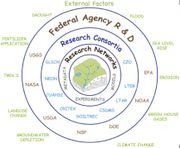What Is Organic Data Science
From Organic Data Science Framework
Organic Data Science allows scientists to formulate and resolve science processes through an open framework that facilitates ad-hoc participation and entice collaborators based on attractive science goals.
Accomplishing this requires three elements: a science approach to tackle the problem of the age of water, a technical substrate that facilitates transdisciplinary collaborations, and a social approach to engage the community:
- Technical approach: Human Computing to Support Organic Team Science. We are pursuing a social computing approach that takes into account human aspects such as incentives and participation, while providing the fabric for representing and coordinating tasks involved in accomplishing science goals. Our approach will openly expose science tasks, facilitating inspection and engagement of new potential contributors. The collaboration will grow in an organic way, drawing in people and other contributions from existing data providers and cyberinfrastruture resources.
- Science approach: Focus on the Lake-Catchment Isoscape. We intend to apply the notion of a catchment isoscape for stable isotopes of water to examine the implication of age and residence time on biogeochemical cycles of coupled catchment-lake systems. This will require integrating the analytical frameworks developed within two communities – hydrology and isotope modeling in Critical Zone Observatories (CZOs) and hydrodynamic water quality modeling from the Global Lake Ecological Observatory Network (GLEON) – to quantify water and material fluxes with existing data and resources from two research sites, the Shale Hills CZO and the GLEON member site, North Temperate Lakes LTER. This foundation will serve as a nexus for participation by multiple communities in the proposed science and will seed the growth of additional science through shared ideas, knowledge, and data.
- Social approach: Engaging the Community. Tremendous potential resides in the collective resources of the highly distributed science community. We can realize that potential by creating an exciting and engaging environment in which individuals can contribute their unique resources, and gain in return, additional resources, including knowledge, credit, and an expanded network. We are collaborating with investigators from diverse areas of research committed to supporting information sharing for advancing Earth and environmental sciences on a scale much larger than we could accomplish individually or even through any one discipline.
Read more about how to participate and contribute.
This is a preliminary article about this work:
- “Organic Data Sharing: A Novel Approach to Scientific Data Sharing.” Gil, Y.; Ratnakar, V.; and Hanson, P. In Second International Workshop on Linked Science: Tackling Big Data (LISC), held in conjunction with the International Semantic Web Conference (ISWC), Boston, MA, 2012. Available as a preprint.
